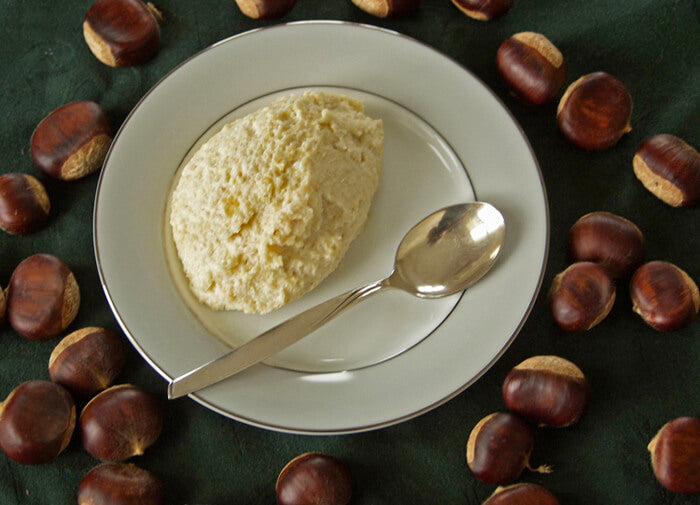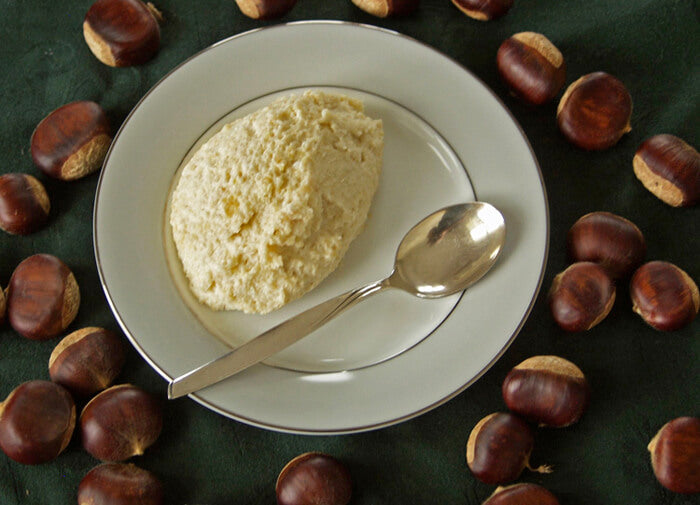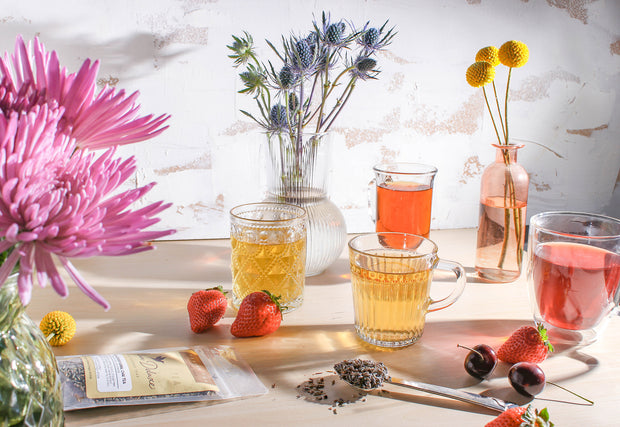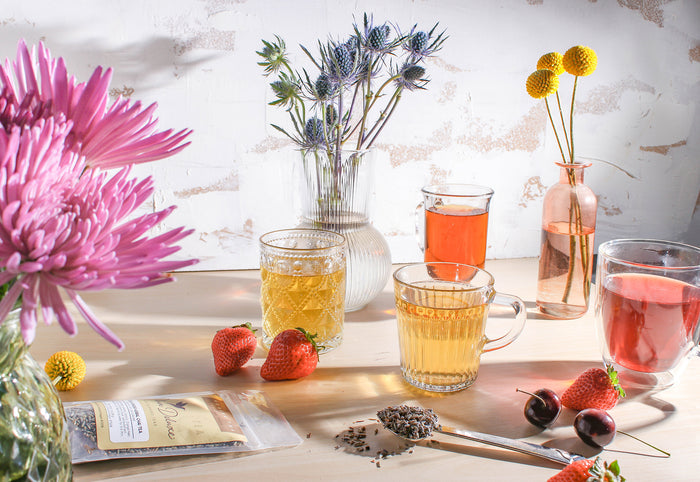Well, German cuisine is much more than pork with mounds of sauerkraut and potatoes to be washed down with beer. Unbeknownst to most people, Germany has a highly diverse regional cuisine that uses primarily seasonal ingredients, including a large variety of vegetables and fruits.

For more than a decade I have cooked my way through Germany and I have not even come close to trying out all the recipes. This is the type of German autumn dinner that I would make for friends. Have a seat at my table and enjoy.
All recipes make 6 servings.

Cream of Rutabaga Soup
Rutabagas are a root vegetable that for best flavor is ideally harvested after the first few frosts. Roasting the rutabagas beforehand gives the soup a deep flavor. This vegan soup is creamy without the addition of any cream. It also tastes excellent reheated so it lends itself to be prepared in advance.
Ingredients:
- 1 to 2 rutabagas (about 1.5 pounds)
- 3 tablespoons olive oil
- Salt and freshly ground black pepper
- 1 medium onion, finely chopped
- 2 carrots, chopped
- 2 stalks celery, chopped
- 1 garlic clove, chopped
- 1 teaspoon dried thyme
- 5 cups vegetable broth
- A dash of white wine vinegar
Preparation:
Preheat the oven to 400 degrees F.
Trim and peel the rutabagas and cut them into 1-inch dice. You should have about 1 pound diced rutabagas. Mix with 2 tablespoons of the olive oil and season with salt and pepper. Place in a single layer in a roasting pan and roast for 25 to 30 minutes, or until the rutabagas are soft and start to color at the edges. Turn them once or twice during roasting.
Once the rutabagas come out of the oven, heat the remaining tablespoon olive oil in a large saucepan. Cook the onion, carrots, celery, garlic, and thyme for 6 to 7 minutes, or until they start to soften, stirring often.
Add the rutabagas and the broth and bring to a boil. Reduce to a simmer and cook covered, for 20 to 25 minutes. Puree the soup with a stick blender or in batches in a food processor. Season with salt and pepper to taste and add a dash of white wine vinegar. Serve hot.

Pork Loin Stuffed with Sauerkraut and Apples
This is my adaptation of a stuffed pork belly roast, a specialty from Thuringia in Eastern Germany. If you prefer to use pork belly, simply plan for a longer cooking time. Have the butcher cut a large pocket into the roast for stuffing. The apples may be replaced by pears, and the stuffing can be prepared in advance.
Ingredients:
Stuffing:
- 2 small to medium apples
- 1 tablespoon ghee
- 1 tablespoon sugar
- 1 pound sauerkraut
- 1 small bay leaf
- ½ cup dry white wine
- Salt and freshly ground black pepper
Roast:
- 2.5 pounds center-cut pork loin roast, with a pocket for stuffing
- 2 tablespoons ghee
- 2 medium onions, finely chopped
Special equipment:
- Butcher twine
- A large sewing needle
- A Dutch oven, preferably cast-iron
Preparation:
Peel and core the apples. Quarter and slice them thinly. Heat 1 tablespoon ghee in a saucepan over medium to high heat. Add the apples and cook for 2 to 3 minutes, stirring. Add the sugar and cook, stirring, until the apples soften and caramelize lightly, but do not let them brown.
Drain the sauerkraut in a colander. Rinse it with cold water and drain again. Add the sauerkraut, bay leaf and wine to the pan. Cover and reduce the heat to a simmer. Cook for 10 minutes, stirring once or twice. Season with salt and pepper. Remove the bay leaf and set aside to cool.
Preheat the oven to 350 degrees F.
Pat the roast dry with paper towels and rub with salt and pepper inside and out. Have a needle with about 1 foot of butcher twine ready. Put the cooled stuffing in the center of the roast and sew it shut with the butcher twine. Pat the roast dry with paper towels once more; if the meat is wet from the sauerkraut cooking liquid, it will not brown.
Heat 1 tablespoon ghee in a large skillet and brown the roast all around at high heat. Place it in a Dutch oven.
Heat the remaining tablespoon ghee and cook the onions until translucent and starting to soften, stirring often. Put the onions around the roast in the Dutch oven and add 1/2 cup water. Cover and cook in the preheated oven for 1.5 hours, basting the roast once or twice. Remove the lid and cook for another 15 to 30 minutes until the top is dark brown.
Remove the roast from the Dutch oven and cover with aluminum foil to keep warm. Puree the gravy in the pan and season with salt and pepper.
Remove the twine from the roast. Cut it into thick slices, and serve the gravy separately.
Hasselback Potatoes
These fanned potatoes cannot claim to be an original German dish, but they are a popular festive side. I like them because of the minimum effort for maximum effect.
Ingredients:
- 12 to 18 medium yellow potatoes of equal size
- Olive oil
- Salt
Preparation:
Preheat the oven to 425 degrees F.
Peel the potatoes. Place each potato on a soup spoon and, using a sharp, small knife, make parallel cuts about 1/8 inch apart. The spoon helps making neat cuts without cutting all the way through.
Place the potatoes in a greased roasting pan. Brush them with olive oil and sprinkle with salt. Bake in the preheated oven for 40 minutes, or until the tops are golden brown.

Chestnut Mousse
When fresh chestnuts start to appear in the market in the fall, I always grab as many as I can. They make wonderful gluten-free cakes and desserts. This is a recipe from Palatinate, a region that is world-famous for its wines and less known for its chestnut forests. This dessert not only lends itself to be prepared ahead, it should be made the day before to give it time to set. Some specialty stores carry imported canned chestnut puree. I do not recommend using it because it does not have the same flavor or consistency of freshly prepared chestnuts. You can, however, freeze your whole cooked and peeled chestnuts or ground chestnuts for later use.
Ingredients:
Preparation:
Inspect the chestnuts and discard any with holes or dark, funky-looking spots. Make an x-cut with a small serrated knife on the flat side of each chestnut. Place them in a small saucepan and cover with water. Bring to a boil and cook for 15 minutes, or until the chestnuts can be pierced with a knife.
Set the pan aside until the water is cool enough to touch. Remove the hard shell and the brown inner skin of the chestnuts. Take the chestnuts out of the water one by one; they are much easier to peel that way. Place the peeled chestnuts on paper towels to dry.
Grind the chestnuts very finely in a food processor.
Put 1/4 cup cold water in a small bowl and sprinkle it with the gelatin. Set aside.
Beat the egg whites with a pinch of salt until they stand in stiff peaks. In a separate bowl, whip the heavy cream until it stands in soft peaks. Gradually add the confectioners’ sugar and continue whipping until stiff.
Bring water to a simmer in a small saucepan. Transfer the soaked gelatin into a large ladle and hold it upright into the simmering water. Melt the gelatin and make sure no water gets into the ladle.
Put a few tablespoons of the whipped cream into a small bowl and quickly stir the melted gelatin into it. Add a few more tablespoons of whipped cream. Add this mix to the whipped cream and fold it in with a spatula.
Put the ground chestnuts in a large bowl. Add the egg whites and the orange liqueur and fold it in with a spatula. Add the whipped cream and thoroughly fold it into the mix. Transfer to a large glass serving bowl, or individual glass dessert dishes. Refrigerate for at least 4 hours, or until set.
Photos by Ted Rosen

!['Chocoholic' Chocolate Tea Variety Pack [6-Pack Variety of Flavors]](http://www.plumdeluxe.com/cdn/shop/files/2.01-1800x1800-PlumDeluxe-DAJ-274695.jpg?v=1736886689&width=165)
![Patisserie Dessert Tea Variety Pack [6-Pack Variety of Flavors]](http://www.plumdeluxe.com/cdn/shop/files/4.01_-_1800_x_1800_-_Plum_Deluxe_-_DAJ_-_274695.jpg?v=1736886720&width=165)















